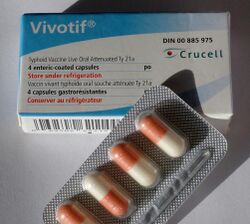Biology:Ty21a
 | |
| Vaccine description | |
|---|---|
| Target disease | Typhoid |
| Type | Attenuated virus |
| Clinical data | |
| Trade names | Vivotif |
| Pregnancy category |
|
| Routes of administration | Oral |
| ATC code | |
| Legal status | |
| Legal status | |
| Identifiers | |
| CAS Number | |
| (verify) | |
Ty21a is a live attenuated bacterial vaccine that protects against typhoid. First licensed in Europe in 1983 and in the United States in 1989, it is an orally administered, live-attenuated Ty2 strain of S. Typhi in which multiple genes, including the genes responsible for the production of Vi, have been deleted so as to render it harmless but nevertheless immunogenic. It is one of the three typhoid vaccines currently recommended by the World Health Organization (the other two being the Typhoid Conjugate Vaccine (TCV) and Vi capsular polysaccharide vaccine).[1]
The vaccine is given by mouth. The vaccine is presented either as enteric coated capsules or as a liquid suspension. The vaccine must be stored at 2 to 8 °C, but will retain its potency for 14 days at 25 °C.[2]
Medical uses
The vaccine offers a statistically significant protection for the first seven years.[3] The vaccine is most commonly used to protect travelers to endemic countries, but some agencies claim that the vaccine could be used in large scale public prevention programs.[2]
The Vi polysaccharide vaccine is also effective at preventing typhoid fever.[3]
Dosing
The recommended dose varies according to country and preparation. At least three doses are required for protection.[4]
In the US and Canada, an initial course of 4 doses on alternate days is recommended. Full protection is achieved 7 days after the last dose. In the US, a booster dose is recommended after 5 years. In Canada, a booster dose is recommended after 7 years.[citation needed]
In Australia and Europe, an initial course of 3 doses on alternate days is recommended. Protection is achieved 7 days after the last dose. A booster dose is recommended every 3 years for people living in endemic areas, but every year for people traveling from non-endemic to endemic areas.[5]
Side effects
Side effects of this vaccine are mild and rare.[3][4]
Trade names
- Vivotif (manufactured by Emergent BioSolutions)[6]
Research
Ty21a may also provide some degree of protection against paratyphoid fever A and B.[7] This cross-protection by a typhoid vaccine is most likely due to O antigens shared between different S. enterica serotypes.[8]
A newer Vi-rEPA vaccine is being tested for preventing typhoid fever. It has a similar level of protection, but the protection may last longer with this newer vaccine.[3]
References
- ↑ "WHO position paper on typhoid Vaccines, March 2018". March 2018. https://www.who.int/immunization/policy/position_papers/PP_typhoid_2018_summary.pdf.
- ↑ 2.0 2.1 "Typhoid vaccines: WHO position paper". Relevé Épidémiologique Hebdomadaire 83 (6): 49–59. February 2008. PMID 18260212. https://www.who.int/wer/2008/wer8306.pdf.
- ↑ 3.0 3.1 3.2 3.3 "Vaccines for preventing typhoid fever". The Cochrane Database of Systematic Reviews 2018 (5): CD001261. May 2018. doi:10.1002/14651858.CD001261.pub4. PMID 29851031.
- ↑ 4.0 4.1 "World Health Organization Information sheet: Observed rate of vaccine reactions- Typhoid Vaccine". April 2014. https://www.who.int/vaccine_safety/initiative/tools/Typhoid_vaccine_rates_information_sheet.pdf.
- ↑ ""Chapter 33: Typhoid"". Immunisation against infectious disease. Department of Health. 2006-12-11. p. 418. ISBN 0-11-322528-8. http://www.dh.gov.uk/prod_consum_dh/groups/dh_digitalassets/@dh/@en/documents/digitalasset/dh_125348.pdf.
- ↑ "Our Products". https://www.emergentbiosolutions.com/products-services/our-products/.
- ↑ "Ty21a live oral typhoid vaccine and prevention of paratyphoid fever caused by Salmonella enterica Serovar Paratyphi B". Clinical Infectious Diseases 45 (Suppl 1): S24–S28. July 2007. doi:10.1086/518141. PMID 17582564.
- ↑ "Rethinking typhoid fever vaccines: implications for travelers and people living in highly endemic areas". Journal of Travel Medicine 16 (1): 46–52. 2009. doi:10.1111/j.1708-8305.2008.00273.x. PMID 19192128.
External links
 |

